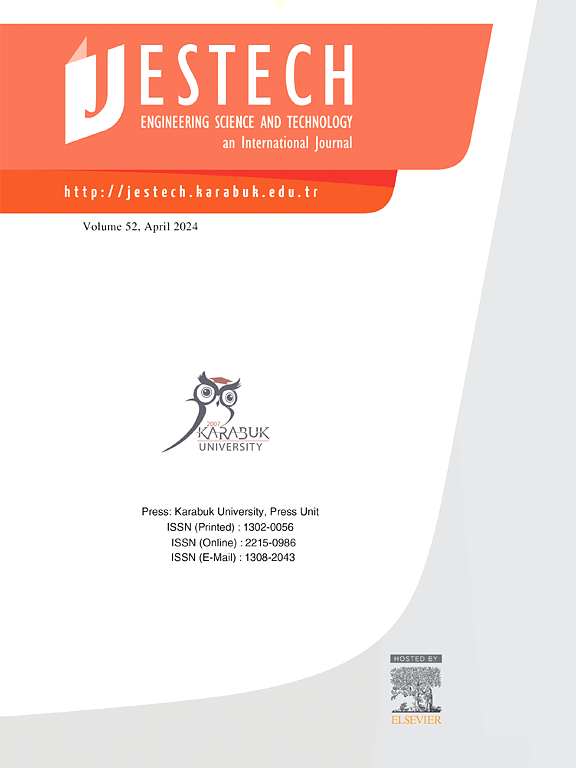Passive flow control devices for road vehicles: A comprehensive review
IF 5.1
2区 工程技术
Q1 ENGINEERING, MULTIDISCIPLINARY
Engineering Science and Technology-An International Journal-Jestech
Pub Date : 2025-02-01
DOI:10.1016/j.jestch.2025.101953
引用次数: 0
Abstract
Aerodynamic drag reduction is considered to be one of the most effective ways to minimize fuel consumption. Hence, this work focuses on reviewing some of the most promising passive flow control techniques for drag and lift reduction in automotive vehicles for enhanced stability and reduced fuel consumption. Firstly, the working physics behind different strategies, like deflectors, diffusers, spoilers, vortex generators, and flaps were elaborately discussed, followed by a detailed comparison among these techniques in terms of resultant drag and lift forces. Among several strategies, the gurney flap showed the huge potential of reducing 67.74% drag force with a slight increase in the lift force. Moreover, straight and concave deflectors can reduce lift force by 118.89% that will improve the aerodynamic stability of the vehicle by a large margin. This study reveals that a combination of a gurney flap, straight-concave deflector, angled fin diffuser, cylindrical vortex generator, and sports wing-lip spoiler is expected to provide the best aerodynamic performance and needs to be further investigated numerically and experimentally. The future scope of the current study is also presented at the end along with the current challenges associated with the implementation of various passive flow control techniques on road vehicles.
道路车辆被动流量控制装置:综述
气动减阻被认为是减少燃油消耗的最有效方法之一。因此,本文将重点介绍一些最有前途的被动流量控制技术,以降低汽车的阻力和升力,从而提高稳定性和降低油耗。首先,详细讨论了不同策略(如偏转板、扩散器、扰流板、涡发生器和襟翼)背后的工作物理原理,然后详细比较了这些技术在综合阻力和升力方面的差异。在几种策略中,轮床瓣显示出巨大的潜力,可以减少67.74%的阻力,而略微增加升力。此外,直型和凹型的偏转板可以减少118.89%的升力,这将大大提高车辆的气动稳定性。研究表明,轮床襟翼、直凹导流板、角度翅片扩散器、圆柱形涡发生器和运动翼唇扰流板的组合可以提供最佳的气动性能,需要进一步的数值和实验研究。最后还介绍了当前研究的未来范围,以及目前在道路车辆上实施各种被动流量控制技术所面临的挑战。
本文章由计算机程序翻译,如有差异,请以英文原文为准。
求助全文
约1分钟内获得全文
求助全文
来源期刊

Engineering Science and Technology-An International Journal-Jestech
Materials Science-Electronic, Optical and Magnetic Materials
CiteScore
11.20
自引率
3.50%
发文量
153
审稿时长
22 days
期刊介绍:
Engineering Science and Technology, an International Journal (JESTECH) (formerly Technology), a peer-reviewed quarterly engineering journal, publishes both theoretical and experimental high quality papers of permanent interest, not previously published in journals, in the field of engineering and applied science which aims to promote the theory and practice of technology and engineering. In addition to peer-reviewed original research papers, the Editorial Board welcomes original research reports, state-of-the-art reviews and communications in the broadly defined field of engineering science and technology.
The scope of JESTECH includes a wide spectrum of subjects including:
-Electrical/Electronics and Computer Engineering (Biomedical Engineering and Instrumentation; Coding, Cryptography, and Information Protection; Communications, Networks, Mobile Computing and Distributed Systems; Compilers and Operating Systems; Computer Architecture, Parallel Processing, and Dependability; Computer Vision and Robotics; Control Theory; Electromagnetic Waves, Microwave Techniques and Antennas; Embedded Systems; Integrated Circuits, VLSI Design, Testing, and CAD; Microelectromechanical Systems; Microelectronics, and Electronic Devices and Circuits; Power, Energy and Energy Conversion Systems; Signal, Image, and Speech Processing)
-Mechanical and Civil Engineering (Automotive Technologies; Biomechanics; Construction Materials; Design and Manufacturing; Dynamics and Control; Energy Generation, Utilization, Conversion, and Storage; Fluid Mechanics and Hydraulics; Heat and Mass Transfer; Micro-Nano Sciences; Renewable and Sustainable Energy Technologies; Robotics and Mechatronics; Solid Mechanics and Structure; Thermal Sciences)
-Metallurgical and Materials Engineering (Advanced Materials Science; Biomaterials; Ceramic and Inorgnanic Materials; Electronic-Magnetic Materials; Energy and Environment; Materials Characterizastion; Metallurgy; Polymers and Nanocomposites)
 求助内容:
求助内容: 应助结果提醒方式:
应助结果提醒方式:


